
Nibiru - Planet X - the Anunnaki - Sumerian Mythology

Zecharia Sitchin has devoted his life to the study of ancient Sumerian civilzation, language, art, and religion. Sitchen is also the author of several books which explain his theories about human origins on earth and the involvement of the "ancient astronauts", a group called the "Annunaki" (or "Nephilim") whom "from heaven to earth came", inhabitants from the planet Nibiru, also known as planet X, the tenth planet in our solar system, and one that the ancients of the past knew about and depicted in their mythology.
Zacharia Sitchen and his Theory
a cosmic collision - the anunaki arrive - gold mining on earth - biogenetic experiments the gods send a flood - the return of planet X - babylonian creation - Nibiru and Tiamat
Sumerian creation myth
the deluge myth - heaven and earth
Sumerian Creation Myth and the gods/goddesses
An and Ki - The union of Heaven and Earth and the creation of the gods
Nibiru, Tiamat and the Anunnaki in Babylonian Mythology
References to The Nephilim (or "Giants") in Biblical Texts
References, Resources, and Links
Sumeria (Sumer)
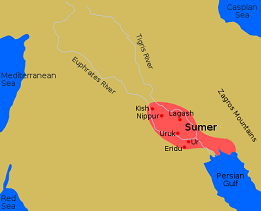 Sumer was an ancient civilization located in what is now Southern Iraq, around the 5th - 4th millennium BC untill the rise of Babylon in the Second Millenium BC. The ancient land was then known as Mesopotamia a name that is greek for "the land between the rivers" which was a reference to the Tigres and Euphrates rivers, but also included parts of present day Syria and Turkey. The region by the same name is known as the "Cradle of civilization" because it seems that civilization had abruptly emerged there about 6,000 to 8,000 years ago.
Sumer was an ancient civilization located in what is now Southern Iraq, around the 5th - 4th millennium BC untill the rise of Babylon in the Second Millenium BC. The ancient land was then known as Mesopotamia a name that is greek for "the land between the rivers" which was a reference to the Tigres and Euphrates rivers, but also included parts of present day Syria and Turkey. The region by the same name is known as the "Cradle of civilization" because it seems that civilization had abruptly emerged there about 6,000 to 8,000 years ago.
The Sumerians are often considered to be the first true civilization on planet earth. Some of the earliest written records of man that are still in existance are of Sumerian origin; Sumerian cuneiform is the earliest written language and was borrowed by the Babylonians who also adopted many of their religious beliefs. There are even traces and parallels of Sumerian myth that can be found in the Genesis story of the Bible. Some scholars believe that biblical "garden of eden" was located in what is now Iraq. The religion of the ancient Sumerians has left its mark on the entire middle east.
Zacharia Sitchen and his Theory
Zecharia Sitchin has devoted his life to the study of ancient Sumerian civilzation, language, art, and religion. He has also studied ancient Hebrew and other Semitic and European languages, the Old Testament, and the history and archeology of the Near East in general. He is also the author of several books which explain his theories about human origins on earth and the involvement of the "ancient astronauts".Zacharia Sitchin used archeological evidence and translations from tablets of Sumerian writings to develop his theories. He believes that the creation of the ancient Sumerian people was the result of the "Annunaki" (or "Nephilim"), a race of beings from a planet he calls Nibiru. This undiscovered tenth planet is also known as Planet X.
Sumerian mythology and archeological evidence may also reflect this view that the human race was visited by a group of extraterrestrials from Nibiru (and possibly races from other star systems in the galaxy). Part of Sitchen's theory is also based on the astronomical interpretation of the Babylonian creation myth (the Enuma Elish), sumerian mythology, and the careful study of ancient sumerian clay tablets.
A Cosmic Collision
 Sitchen's theory explains that sometime around 65 million to 4 billion years ago, the solar system looked much different than it does today. A planet referred to as Tiamat, a thriving and inhabited planet at the time, may have existed between Mars and Jupiter. The orbit of Tiamat was suddenly disrupted by the arrival of a much larger planet (or possibly a star almost the size of jupiter); this incoming object passed through the solar system and the new orbits caused Tiamat to collide with Nibiru.
Sitchen's theory explains that sometime around 65 million to 4 billion years ago, the solar system looked much different than it does today. A planet referred to as Tiamat, a thriving and inhabited planet at the time, may have existed between Mars and Jupiter. The orbit of Tiamat was suddenly disrupted by the arrival of a much larger planet (or possibly a star almost the size of jupiter); this incoming object passed through the solar system and the new orbits caused Tiamat to collide with Nibiru.
The incoming object that collided with Tiamat was the planet referred to as Nibiru; this planet follows a long elliptical orbit which reaches our inner solar system every 3,600 years. There was much debris left behind from this cosmic collision which may have resulted in the formation of the asteroid belt, the moon, and our current planet Earth. Nibiru's passing also caused a gravitational disruption that resulted in Pluto (at the time a satellite of Saturn) being thrown into its own orbit beyond Neptune.
The first passing of Nibiru resulted in one of its Moons being struck by Tiamat; this resulted in Tiamat being split into two halves. A second passing of Nibiru then struck these broken fragments of Tiamat, one of the fragments became the asteroid belt; the second half was struck again by one of Nibiru's moons; this second half was pushed into a new orbit and became our current planet earth. a name="theanunakionearth">
The Anunaki arrive
Sitchen's theory further explains that Nibiru was once (and could still be) the home of a technologically advanced (human-like) extraterrestrial race called the Annunaki. In Sumerian/Babylonian Mythology the Annunaki were a group referred to as the elder gods; they are related to the Nephilim that are depicted in Genesis of the Bible.
Mining the Gold on Earth
Sitchin tells us that the reason why the Anunaki had originally come to earth was due to a problem on their home planet; the gradual cooling of the planet caused the atmosphere of Nibiru to deteriorate, and one solution to the problem was to scatter particles of gold-dust into the atmospheric core to act as a reflective shield of sorts. The Anunnaki discovered that the planet Tiamat (Earth) had a large quanitity of the minerals they needed in this last effort to save their home world.
When the orbit of Nibiru came close enough to earth travel between the two was made possible and "space stations" may have also been set up on mars. Annunaki rank and file workers may have been first sent out for this purpose. Atmospheric conditions on earth were also similar to their own so the Anunaki may have already planned on inhabiting Earth permenantly, while happening upon the gold and other precious minerals in the process. The gold mining may have taken place in the South African region where it was shipped to Mesopotamia and later back to their home planet.
After arriving on earth, the Anunaki discovered that the planet was already inhabited by the primitive homo erectus, whom were the result of millions of years of earth evolution. Later, a few of the Anunnaki gods came up with an idea to produce a new workforce to assist them in their duties. They eventually decided to genetically engineer the Homo Sapien race by crossing their own genes with those of Homo Erectus primates. The combination of anunnaki D.N.A with that of the primitive man created a hybrid "superhuman", or "the first adam". The new Homo Sapien was "created in their own image".
This new human-slave-workforce was produced solely to assist the annunaki in the mining of the gold and other laborious duties. The new human creation probably thought of these cosmic visitors/creators to be like "gods". Another theory is that the Anunaki gods simply inter-bred with the inhabitants already on the earth(homo erectus); these "sons of god" had sinful relations with the "daughters of men" which resulted in the creation of the hybrid man, the offspring were thus "godly" in this is where the nephilim of the bible comes into play.
The ancient Sumerian inscriptions indicate that the human civilization in Sumer of Mesopotamia was set up under the authority and guidance of these Annunaki gods. Kingship was assigned to the half-breeds creations that resulting from the union of the gods and men; they were to act as mediators or agents between mankind and the Anunnaki. Later rebellion occurred, chaos and evil was abundant, and fallout from nuclear weapons (present on earth at the time because of the advanced techologies of the Annunaki) were used during a war between the gods and a minority group of men; this is the "evil wind" that destroyed Ur around 2000-2024 BCE and possibly the event that is described in the Lament for Ur.
The gods may have eventually decided to "wipe out" this evil creation of theirs as a result of their disobedience. Or as some follows of the Anunaki theory believe, it was another near approach/passing of Nibiru around 11,000 B.C.E. that could have led to the destructive flood recounted in the Genesis of the Bible. One individual was warned of the impending flood (Noah and his family in the bible) and were able to escape after building a boat. After the flood, life began to slowly flourish once again with the assistance of the Anunnaki Enki, who was also the one that had issued the forewarning of the flood that was to be sent by An and Enlil .
The Anunaki gods (or some of them) may have left the earth at this time during the next passing of their home planet Nibiru. Many followers of the Anunaki theory believe that they may still be on the earth today or that they are due to return at the next passing of Nibiru. Another theory about Nibiru that is not supported by Sitchen, currently identifies the mysterious planet X as a large brown dwarf star that is currently within our planetary system and will soon be passing relatively close to the Earth; this could lead to a disruption of the orbits once again, resulting in another "cosmic catastophe" or the return of the Anunaki gods.
Babylonian Creation - Nibiru and Tiamat
Nibiru is referenced in the Babylonian poem Enuma Elish, and is associated with the god Marduk; it is also identified as the planet Jupiter. According to the Babylonians, the object Nibiru was the celestial body (or region) that was often associated with the god Marduk; Marduk is also depicted as the heir "Anu" (god of the heavens) . Since the hypothetical planet Nibiru can be referred to as Marduk, the return of Nibiru may actually be the return of that which is represented by/as Marduk, the "son of god".
Nibiru is often considered the 'Planet of the Crossing.' and to the Babylonians it is referred to as "Marduk", named after their chief god an protector of Babylon. The lifespans of the Anunaki were longer than those of the inhabitants on earth (over a hundred years). One year on planet Nibiru is often considered equivalent to 3,600 Earth years. In Babylonian creation myth Tiamat is considered to be the goddess that personifies the sea, the monstrous embodiment of primordial chaos, and also connected to "the deeps" or "the abyss" that is depicted in Genesis. Tiamat is also represented as a dragon or serpent (snake) or is said to have given birth to such creatures. Tiamat creates or gives birth to first gods/deities but later wars with them. Tiamat is killed by the god Marduk (nibiru). The heavens and earth are formed from the divided body of Tiamat. Official Website of Zacharia Sitchen

Images from several Sumerian clay tablets which may be depicting the Anunnaki (nephilim/giants) and possible "flying vehicles" or advanced spacecraft used by the Anunnaki gods to descend to the earth.
Maybe we will never know the truth. The key is to look for similarities (parallels) between the myths and stories of one culture compared to another. These may provide us the necessary "clues" to piece together what happened and what didn't - what "feels" right and what doesn't. Images and ymbolism is a reflection of the collective consciousness of mankind. The sub-conscious already knows the truth and it's the emotional reaction to the symbols and mythological parallels that cause one to re-think their current conditioned belief systems. It doesn't hurt to think outside the box and explore the possibilities. New theories lead to new discoveries and new discoveries lead to new theories. truth.
Possible Orbit of the hypothetical Nibiru (Planet X) as it made its 3,600 year eliptical orbit through our solar system disrupting the orbit of Tiamat (now earth) and the path it will once again take upon its possible return.
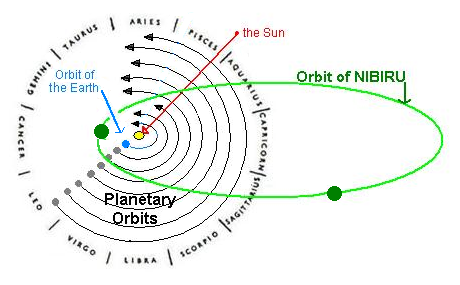
Sumerian Akkadian Seal - Possible representation of our own solar system with the sun in the center and surrounding by the 10 planets, the one on the top far left side theorized to be Nibiru, planet X.
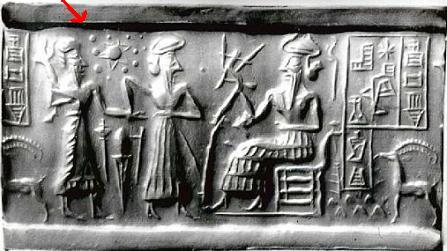
"there were giants on the earth in those days..." - If the individual who is seated were to stand upright, how tall do you think he would be?
The Creation in Sumerian Mythology
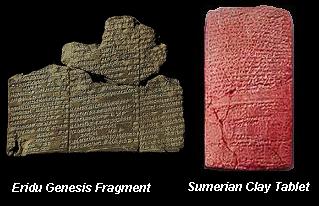 The Sumerian creation myth is the oldest known to mankind. These writings were found in fragments on a clay tablet that is know as the "Eridu Genesis" and dates back to around ca. 18th Century BCE. The Eridu Genesis story describes the creation of mankind by the four great gods known as the Annunaki. (An, Enlil, Ninhursag, and Enki) whom create the Sumerians (referred to as the "black-headed people". From "heaven to earth they came"; they descending from the sky to establish the various cities on earth. These ancient writings also describe a flood myth that predates the same myth that is found in the genesis of the Christian bible and in other ancient myths around the world.
The Sumerian creation myth is the oldest known to mankind. These writings were found in fragments on a clay tablet that is know as the "Eridu Genesis" and dates back to around ca. 18th Century BCE. The Eridu Genesis story describes the creation of mankind by the four great gods known as the Annunaki. (An, Enlil, Ninhursag, and Enki) whom create the Sumerians (referred to as the "black-headed people". From "heaven to earth they came"; they descending from the sky to establish the various cities on earth. These ancient writings also describe a flood myth that predates the same myth that is found in the genesis of the Christian bible and in other ancient myths around the world.
Deluge Myth
Enlil is annoyed at the noise (or evil) of humankind and convinces the other gods to send a flood to destroy humankind, and one named Zi-ud-sura, referred to as the "king and priest", learns of the plan. Zi-ud-sura is instructed by "Enki" (or Ea in Babylonian mythology), the god of the waters, to build a large boat so he and the selected animals of the earth can survive the flood. A terrible storm rocks the boat for seven days and seven nights, then Utu (the Sun god) appears and Zi-ud-sura creates an opening in the boat.
When the flood completely ceases, the animals emerge, and also Zi-ud-sura and his family, who then fall into submission, offers praise, adoration and sacrifices to An (the sky-god) and Enlil (chief of the gods), for sparing their lives. The gods give Zi-ud-sura eternal life and take him to dwell in the land of Dilmun for his act of preserving the animals and the seed of mankind.
Heaven and Earth
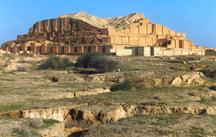 Each walled city of Mesopotamian civilization was centred upon a temple complex called a ziggurat.
These ziggurats were elevated stair-towers that stretched upwards toward the heavens and were shaped somewhat like a pyramid. Each level of the Ziggurat was devoted to the sun, moon, a god aspect, or to one of the known stars in the sky. The ziggurats were considered to be a place "closer to the heavens" and also a shrine or "gateway to the gods" ; it was also a place for the ruler god of the sky "An" to rest his feet.
Each walled city of Mesopotamian civilization was centred upon a temple complex called a ziggurat.
These ziggurats were elevated stair-towers that stretched upwards toward the heavens and were shaped somewhat like a pyramid. Each level of the Ziggurat was devoted to the sun, moon, a god aspect, or to one of the known stars in the sky. The ziggurats were considered to be a place "closer to the heavens" and also a shrine or "gateway to the gods" ; it was also a place for the ruler god of the sky "An" to rest his feet.
The Sumerians regarded the world as eternal and with no beginning or end. The celestial bodies were considered to be either intelligent beings in their own right, or were being controlled or guided by some other higher intelligence; The heavenly host was considered to be mediator between God and humanity. This belief eventually developed into Chaldean astrology, which was particular to the mathematics and astrology of Babylonia in general.
The Sumerian belief was that the sacred heavens mirrored the terrestrial earth plane; wars between the cities on earth paralleled the conflicts between the divinities in heaven. The movement of the celestial bodies of the heavens and their associations with earth were charted carefully; this information was used for compling lists of historical events.
Various public rituals, food sacrifices, and libations took place in the Sumerian Temples on a daily basis. There were monthly feasts and annual New Year celebrations. During the later, the king would be married to Inanna as the resurrected fertility god Dumuzi.... Sumerian Mythology FAQ
An(Anu) meaning Heaven/sky
Na meaning And
Ki meaning Earth
Sumerian Creation Myth and the gods/goddesses
*Many of the named-gods have similar attributes or roles; this is because they are describing different aspects of the same god.
An represented heaven to the Sumerians; An/Anu was the main god of the pantheon and was referred to as "the God of the sky", "the father of the gods", and "the lord of constellations"; He was also the "god of kings/king of gods" and the god of the yearly calendar. The pantheon of gods (An, Enlil, and Enki) were typically depicted in a headdress or royal tiera along with two pairs of bull horns, which was symbolic of strength, and also with long beards. Sumerian deities were usually associated with the various regions of the earth and sky.
According to the Sumerians, the universe's creation (anki) begins with the the primeval sea (abzu) which existed in the beginning before anything else; the heaven (an) and the earth (ki) were formed within this; (anki = heaven and earth). The boundary between the heaven and earth was considered to be a solid-like vault that contained a gas-like atmosphere (lil); the brightest portions formed the sun, moon, stars, and planets.
An and Ki - The union of Heaven and Earth and the creation of the gods
In the first days all needed things were created. Heaven and earth were separated. An took Heaven and Enlil took the earth.
An is the main god of heaven and sky. Ki is the original earth goddess and mother of the gods who assists in the creation of man. The union between An(heaven) and Ki(earth) produced the air-god Enlil (Lord of 'lil' - the god of breath and wind). An and Ki/Ninhursag were the creators of most of the other gods. Enlil assumed most of sky-god An's power and became his heir and the leader of the pantheon; he is also glorified as "'the father of the gods", "the king of heaven and earth", and also "the king of all the lands".
Later Ki, Enlil, and Enki produce the plant and animal kingdoms and Enlil assisted in giving the various gods/goddesses and kings their earthly regions of influence and their laws. Enlil also rules over the dawn of the day and the agriculture of the land. He is also banished to the netherworld (kur) for his rape of Ninlil, his soon-to-be bride. The result of the union produces Sin, the Moon God (also known as Nanna).
The mother goddess of earth Ki is also later personified as Ninhursag (the queen of the mountains) Ninmah (the exalted lady) and Nintu(the lady who gave birth),amoung other names. Other traditions depict Enlil as the the brother of Ninhursag, and others her husband.
She also plays anther role, in that of the advisor of Enki as he shaped several versions of man from clay., over the Abzu. In Dilmun, she bore "eight trees" or offspring from Enki, which he ate, resulting in Ki cursing him with "eight wounds". After being pursuaded by Enlil to undo the curse she bore Enki eight new children who then undid the wounds of the first.
Enki is the lord of the abzu (the watery abyss) and of wisdom itself. He may have once been known as En-kur, the lord of the underworld which may be the same as the Abzu. He is also known as the Lord of Kur, and the god of water, creation, fertility, and semen. He is the keeper of the "me" (the divine laws). The divine laws were established by Enlil in Ekur and given to Enki to guard and to impart on the people. Later, Inanna (Sumerian goddess of love, fertility and war - also known as Ishtar) comes to Enki, unsatisfied because she was given less powers; in other version Inanna gets Enki drunk and he grants her more power, particularly power over the arts and crafts. Inanna brings these powers back to the center of Erech.
Babylonian Creation Myth and the Anunaki
The Annunaki are referenced in the Babylonian creation myth, Enuma Elish. In Babylonian cosmology/mythology Nibiru is associated with Marduk. Tiamat is described in the Enuma Elish as a goddess. The Anunnaki were the children of Anu (the sky-god of the heavens).The name Anunnaki is also known as Anunnaku and Ananaki. This group of Sumerian and Akkadian deities is related to/overlapping with the Annuna, whom are the 'Fifty Great Gods', and also the Igigi, the minor gods. a-nu-na or a-nuna-ke can be translated to mean 'those of royal blood', 'princely offspring' or "heaven and earth" (Anu-na-ki). Ki in Sumerian mythology was the goddess/personification of the earth and of the underworld; she was also chief companian of Anu the sky god; she is the mother goddess and union between her and An create the subsequent gods of the earth. In some texts the Ki and An were represented as brother and sister, being the offspring of Anshar and Kishar whom were earlier personifications of heaven and earth.
In the Babylonian mythology creation myth Marduk was regarded as the son of Ea (in Sumerian this is 'Enki') and Damkina, and the heir of Anu. Marduk took over the role of Enlil and rose to the highest position of power.Marduk was also known as the patron deity of the city of Babylon; during this time Babylon officially became the political center of the Euphrates valley in the time of Hammurabi. Marduk started to began to slowly rise in power to the position of the head of the Babylonian pantheon. After the creation of mankind Marduk divides the Anunnaki and assigns them each to their proper stations, (three hundred in heaven and three hundred on the earth.) In gratitude, the Annunaki (referred to as the "Great Gods") built Esagila, a temple dedicated to Marduk , the protector god of Babylon. The temple lays south of the ziggurat Etemenanki, the memory of which has actually been prevailed in the Judeo-Christian culture as the 'Tower of Babel".
TIAMAT
The Babylonian religion is largely derived from Sumerian mythology. Texts were written in a Semitic language called Akkadian by using cuneiform script on clay tablets. The word Tiamat is derived from the Sumerian ti which means life and from ama meaning mother. In the Bible, the herbrew word Tehom translates to "the deep" or the "abyss" and refers to the primordial waters of creation as mentioned in Genesis 1:2.
In Babylonian mythology, Tiamat has a similar meaning and is represented as a goddess who personifies the sea and is the monstrous embodiment of the primordial chaos. She is sometimes identified with a sea serpent, snake or dragon. The Babylonian creation epic En?ma Elish describes how she gave birth to the first generation of deities/gods; she later makes war with them and is killed by the god Marduk. The heavens and the earth are then formed from her divided body.
NIBIRU *Nibiru, to the Babylonians, was the celestial body or region sometimes associated with the god Marduk. In En?ma Elish, a civil war between the gods was growing to a climactic battle. The Anunnaki gods gathered together to find one god who could defeat the gods rising against them. Marduk, a very young god, answered the call and was promised the position of head god.
When he killed his enemy, he "wrested from him the Tablets of Destiny, wrongfully his" and assumed his new position. Under his reign humans were created to bear the burdens of life so the gods could be at leisure.
*referenced from Wikipedia article on Marduk
References to The Nephilim (or "Giants") in Biblical Texts.
The Anunaki are associated with the Nephilim of the Bible in some theories, like those of Zecharia Sitchin.
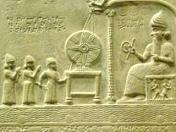 The Nephilim are referenced in Hebrew Bible, most notablely in the Book of Genesis; the Nephilim are also mentioned in other Biblical texts and in some non-canonical Jewish writings. According to Zacharia Sitchen, these giant beings were warlike in nature and whom "from heaven to earth came" are the the same Anunnaki as depicted in the Sumerian myths. The flood story is referenced in both texts as well.
The Nephilim are referenced in Hebrew Bible, most notablely in the Book of Genesis; the Nephilim are also mentioned in other Biblical texts and in some non-canonical Jewish writings. According to Zacharia Sitchen, these giant beings were warlike in nature and whom "from heaven to earth came" are the the same Anunnaki as depicted in the Sumerian myths. The flood story is referenced in both texts as well.
Genesis 6:4 There were giants in the earth in those days; and also after that, when the sons of God came in unto the daughters of men, and they bare children to them, the same became mighty men which were of old, men of renown.
The "giants of Canaan" in the Book of Numbers (13:33) may have been the direct descendants of the Nephilim, or they were fathered by the same super-natural parents. The Anakim(or Anakites) are the descendants of Anak and dwelt in the south of Canaan in Hebron. In the days of Abraham, they dwelt in the region known as Edom and Moab, which lies east of the Jordan river.
Numbers 13:33 And there we saw the giants, the sons of Anak, which come of the giants: and we were in our own sight as grasshoppers, and so we were in their sight.
Regarding the identity of the Nephilim, as depicted in Genesis, there are a few common veiws: They are the offspring of fallen angels and human women; or they were the hybrid offspring of descendants of Seth with those of Cain; the original biblical author may have intended the Nephilim to be an "anecdote of a superhuman race".
The etymology of the hebrew word Nephilim may mean "those causing others to fall"; nephilim can also be derived from the Hebrew word Pela which means wondrous. The term is often considered a generic term for "giants" in general.
In ancient Aram from which the Aramaic language is derived, the word Nephila reffers to the constellation of Orion, and Orion's semi-divine descendants were known as Nephilim (cf. Anakim from Anak); this could imply that they are of the same origin of the Nephilim in the Bible.
The Book of Enoch
The story of the Nephilim is chronicled in more detail in the Book of Enoch. This Book was considered scripture by many early Christians and it was widely known and read during the first few centuries after Christ. The Book of Enoch, along with many others, became discredited after the Council of Laodicea and put under ban of the authorities; it gradually passed out of circulation. The book was considered lost until it was found 1773 in Abyssinia, after the discovery of cave 4 of the Dead Sea Scrolls. Seven fragmented copies of the Aramaic text were discovered.
The Book of Enoch is kept out of most current bibles and is considered to be a pseudepigraphic work, although the book is quoted in the New Testament (Letter of Jude 1:14-15) and by many early church fathers. The Ethiopian Orthodox Church regards the Book of Enoch to be canonical.
Enoch was the great-grandson of Adam via the Cain bloodline (others say he is descendant from Seth); he was also considered the grandfather of Noah
And Enoch walked with God: and he was not; for God took him. - Genesis 5:24
Enoch lived 365 years and escaped death because he was "taken up by god" or "transformed" in some way. 365 days corresponds to the solar year approximately. Enoch is linked with the ancient Sumerian king Emmeduranki, who was associated with the sun god Utu. Some believe that God then transformed him into the angel Metatron.
When Enoch was taken up to Heaven he was appointed guardian of all the celestial treasures, chief of the archangels, and also the first attendant on God's throne. He is taught all secrets, hidden knowledge and the mysteries of the world; he is often attributed asthe teacher of astronomy, astrology, mathematics, and the inventor of writing.
Enoch is sometimes referred to as "the initiated"; he was known as a prophet and considered an important figure in several major relgions. Enoch may have been one of the Two Witnesses in the Book of Revelation. The Ancient Greeks identified Enoch as Hermes Trismegistus, a syncretic deity. In the New Testament, Jude quotes Enoch as prophesying a day of judgement.
1:14 And Enoch also, the seventh from Adam, prophesied of these, saying, Behold, the Lord cometh with ten thousands of his saints
In the Quran, the prophet Enoch is known as Idris
Enoch, as well as Jubilees, connects the origin of the Nephilim with the "fallen angels", the Grigori (watchers). A high-ranking angel called Samyaza who leads the rebel angels, descends tothe earth plane, mates with the mortal women, then giving rise to a race of hybrids, the Nephilim.
The Book of Jubilees (7:21-25) also mentions that the flood sent by God was for the purpse of ridding the Nehilum from the earth during the time of Noah. There are flood myths in many ancient cultures and other religions besides Christianity. The sumerian mythology also has a flood story where one individual is forewarned of the event by a god and is instructed to build a boat in order to survive and repopulate the earth along with the animals. In the Bible Noah is represented as "perfect in his generation" . This may be a reference to his having "clean blood, that is, a nephilim-free bloodline.
The Book of Enoch.. is one of the most important non-canonical apocryphal works, and probably had a huge influence on early Christian, particularly Gnostic, beliefs.... Filled with hallucinatory visions of heaven and hell, angels and devils, Enoch introduced concepts such as fallen angels, the appearance of a Messiah, Resurrection, a Final Judgement, and a Heavenly Kingdom on Earth. Interspersed with this material are quasi-scientific digressions on calendrical systems, geography, cosmology, astronomy, and meteorology....READ THE BOOK OF ENOCH
 Links and resource on planet x nibiru, sumerian mythology and the annunaki
Links and resource on planet x nibiru, sumerian mythology and the annunaki






